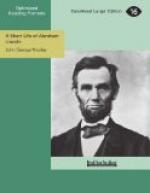While Lee, without halting, crossed the Potomac above Harper’s Ferry, and continued his northward march into Maryland and Pennsylvania, Hooker prudently followed on the “inside track” as Mr. Lincoln had suggested, interposing the Union army effectually to guard Washington and Baltimore. But at this point a long-standing irritation and jealousy between Hooker and Halleck became so acute that on the general-in-chief’s refusing a comparatively minor request, Hooker asked to be relieved from command. The President, deeming divided counsel at so critical a juncture more hazardous than a change of command, took Hooker at his word, and appointed General George G. Meade as his successor.
Meade had, since Chancellorsville, been as caustic a critic of Hooker as Hooker was of Burnside at and after Fredericksburg. But all spirit of insubordination vanished in the exciting stress of a pursuing campaign and the new and retiring leaders of the Army of the Potomac exchanged compliments in General Orders with high chivalric courtesy, while the army continued its northward march with undiminished ardor and unbroken step. When Meade crossed the Pennsylvania line, Lee was already far ahead, threatening Harrisburg. The Confederate invasion spread terror and loss among farms and villages, and created almost a panic in the great cities. Under the President’s call for one hundred thousand six months’ militia six of the adjoining States were sending hurried and improvised forces to the banks of the Susquehanna, under the command of General Couch. Lee, finding that stream too well guarded, turned his course directly east, which, with Meade marching to the north, brought the opposing armies into inevitable contact and collision at the town of Gettysburg.
Meade had both expected and carefully prepared to receive the attack and fight a defensive battle on the line of Pipe Creek. But when, on the afternoon of July 1, 1863, the advance detachments of each army met and engaged in a fierce conflict for the possession of the town, Meade, on learning the nature of the fight, and the situation of the ground, instantly decided to accept it, and ordering forward his whole force, made it the principal and most decisive battle-field of the whole war.
The Union troops made a violent and stubborn effort to hold the town of Gettysburg; but the early Confederate arrivals, taking position in a half-circle on the west, north, and east, drove them through and out of it. The seeming reverse proved an advantage. Half a mile to the south it enabled the Union detachments to seize and establish themselves on Cemetery Ridge and Hill. This, with several rocky elevations, and a crest of boulders making a curve to the east at the northern end, was in itself almost a natural fortress, and with the intrenchments thrown up by the expert veterans, soon became nearly impregnable. Beyond a wide valley to the west, and parallel with it, lay Seminary Ridge, on which the Confederate army established itself with equal rapidity. Lee had also hoped to fight a defensive battle; but thus suddenly arrested in his eastward march in a hostile country, could not afford to stand still and wait.




